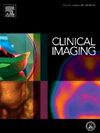Cultivating diagnostic clarity: The importance of reporting artificial intelligence confidence levels in radiologic diagnoses
IF 1.8
4区 医学
Q3 RADIOLOGY, NUCLEAR MEDICINE & MEDICAL IMAGING
引用次数: 0
Abstract
Accurate image interpretation is essential in the field of radiology to the healthcare team in order to provide optimal patient care. This article discusses the use of artificial intelligence (AI) confidence levels to enhance the accuracy and dependability of its radiological diagnoses. The current advances in AI technologies have changed how radiologists and clinicians make the diagnoses of pathological conditions such as aneurysms, hemorrhages, pneumothorax, pneumoperitoneum, and particularly fractures.
To enhance the utility of these AI models, radiologists need a more comprehensive understanding of the model's levels of confidence and certainty behind the results they produce. This allows radiologists to make more informed decisions that have the potential to drastically change a patient's clinical management. Several AI models, especially those utilizing deep learning models (DL) with convolutional neural networks (CNNs), have demonstrated significant potential in identifying subtle findings in medical imaging that are often missed by radiologists.
It is necessary to create standardized levels of confidence metrics in order for AI systems to be relevant and reliable in the clinical setting. Incorporating AI into clinical practice does have certain obstacles like the need for clinical validation, concerns regarding the interpretability of AI system results, and addressing confusion and misunderstandings within the medical community. This study emphasizes the importance of AI systems to clearly convey their level of confidence in radiological diagnosis. This paper highlights the importance of conducting research to establish AI confidence level metrics that are limited to a specific anatomical region or lesion type.
Key point of the view
Accurate fracture diagnosis relies on radiologic certainty, where Artificial intelligence (AI), especially convolutional neural networks (CNNs) and deep learning (DL), shows promise in enhancing X-ray interpretation amidst a shortage of radiologists. Overcoming integration challenges through improved AI interpretability and education is crucial for widespread acceptance and better patient outcomes.
培养诊断清晰度:在放射诊断中报告人工智能置信度的重要性。
在放射学领域,准确的图像解读对医疗团队提供最佳的病人护理至关重要。本文讨论了如何利用人工智能(AI)置信度来提高放射诊断的准确性和可靠性。目前,人工智能技术的进步已经改变了放射科医生和临床医生对动脉瘤、出血、气胸、腹腔积气,尤其是骨折等病理情况的诊断方式。为了提高这些人工智能模型的实用性,放射科医生需要更全面地了解模型所产生结果背后的置信度和确定性。这能让放射科医生做出更明智的决定,而这些决定有可能极大地改变患者的临床管理。一些人工智能模型,特别是那些利用卷积神经网络(CNN)的深度学习模型(DL),在识别医学影像中经常被放射科医生遗漏的细微发现方面表现出了巨大的潜力。有必要建立标准化的置信度指标,以使人工智能系统在临床环境中具有相关性和可靠性。将人工智能融入临床实践确实存在一些障碍,如需要临床验证、对人工智能系统结果可解释性的担忧,以及解决医学界的困惑和误解。本研究强调了人工智能系统明确表达其在放射诊断中的可信度的重要性。本文强调了开展研究以建立仅限于特定解剖区域或病变类型的人工智能置信度指标的重要性。观点要点:准确的骨折诊断依赖于放射学的确定性,而人工智能(AI),尤其是卷积神经网络(CNN)和深度学习(DL),在放射科医生短缺的情况下有望提高 X 射线判读能力。通过提高人工智能的可解释性和教育来克服整合方面的挑战,对于获得广泛认可和改善患者治疗效果至关重要。
本文章由计算机程序翻译,如有差异,请以英文原文为准。
求助全文
约1分钟内获得全文
求助全文
来源期刊

Clinical Imaging
医学-核医学
CiteScore
4.60
自引率
0.00%
发文量
265
审稿时长
35 days
期刊介绍:
The mission of Clinical Imaging is to publish, in a timely manner, the very best radiology research from the United States and around the world with special attention to the impact of medical imaging on patient care. The journal''s publications cover all imaging modalities, radiology issues related to patients, policy and practice improvements, and clinically-oriented imaging physics and informatics. The journal is a valuable resource for practicing radiologists, radiologists-in-training and other clinicians with an interest in imaging. Papers are carefully peer-reviewed and selected by our experienced subject editors who are leading experts spanning the range of imaging sub-specialties, which include:
-Body Imaging-
Breast Imaging-
Cardiothoracic Imaging-
Imaging Physics and Informatics-
Molecular Imaging and Nuclear Medicine-
Musculoskeletal and Emergency Imaging-
Neuroradiology-
Practice, Policy & Education-
Pediatric Imaging-
Vascular and Interventional Radiology
 求助内容:
求助内容: 应助结果提醒方式:
应助结果提醒方式:


